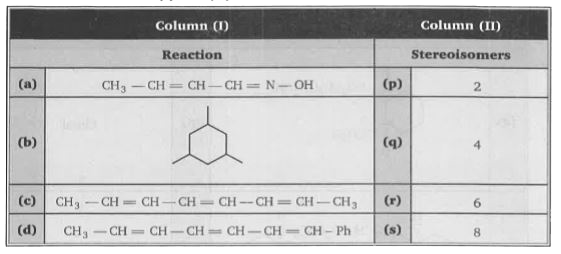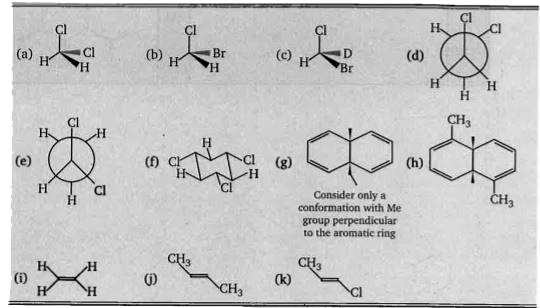CH3−CH=C∣Br−C∣Cl=CH−CH3 Number of geometrical isomers possible for this compound areSolution in Telugu
2
3
4
6
The correct Answer is:C
Total G. I = 22=4
Topper's Solved these Questions
- ISOMERISM (STRUCTURAL & STEREOISOMERISM)Book:MS CHOUHANChapter:ISOMERISM (STRUCTURAL & STEREOISOMERISM)Exercise:LEVEL 2
Explore 66 Videos
- ISOMERISM (STRUCTURAL & STEREOISOMERISM)Book:MS CHOUHANChapter:ISOMERISM (STRUCTURAL & STEREOISOMERISM)Exercise:LEVEL 2 (SUBJECTIVE PROBLEMS)
Explore 17 Videos
- HYDROCARBONS (ALKYNES)Book:MS CHOUHANChapter:HYDROCARBONS (ALKYNES)Exercise:Level -1
Explore 32 Videos
- IUPAC NAME Book:MS CHOUHANChapter:IUPAC NAME Exercise:LEVEL-2 (SUBJECTIVE PROBLEMS )
Explore 1 Video
Similar Questions
Match the Column (I) and (II).

View SolutionNumber of chiral isomers are:

View SolutionComplete the following reaction

View Solution
When IUPAC name of following compound is given, then double bond and substituent gets respectively (x and y) number so the sum of (x + y) will be
View SolutionTotal number of stereoisomers of compound is: CH_(3)-underset(OH)underset(|)CH-underset(Br)underset(|)CH-CH_(3)
View SolutionWrite IUPAC name of the following compound
(a) CH3−CH2−C≡C−CH∣CH2∣CH−CH3∣CH3−CH=CH2
_S01_017_Q01.png)
View SolutionHow many sereoisomera are possible for CH_(3)-underset(Br)underset(|)CH-underset(Cl)underset(|)Cl-underset(Br)underset(|)CH-CH_(3)
View SolutionCH3−CH=C∣Br−C∣Cl=CH−CH3
How many geometrical isomers are possible for this compound?
View SolutionCH3−CH=C∣Br−C∣Br=CH−CH3
How many grometrical isomers of this compound are possible ?
View SolutionWrite the IUPAC name of the following compound:
CH3−C∣BrH−CH2−C∣ClH−CH3
View SolutionCH_(3)-CH= CH-CH_(3)+ Br_(2) to CH_(3)-underset(Br)underset(|)CH-underset(Br)underset(|)CH-CH_(3) is an
View SolutionName the following compounds according to IUPAC system. (i) CH_(3) - CH_(2) - underset (CH_(2)Cl) underset(|)(CH) - overset (CH_(2)OH) overset(|) (CH) - underset (CH_(3)) underset (|) (CH) - CH_(3) CH_(3)- underset (CH_(3)) underset(|) (CH) -CH_(2) - underset(OH) underset(|) (CH) - overset (CH_(2)OH) overset(|) (CH) - CH_(2) (iii) (iv) H_(2)C = CH - underset (OH)underset (|) (CH) - CH_(2) - CH_(2) - CH_(3) (v) CH_(3) - underset (CH_(3)) underset ( |) C = underset (Br)underset(|) C - CH_(2)OH
View SolutionThe number of optical isomers of the compound, CH3−CH∣Br−CH∣Br−COOH is :
View SolutionName the following compounds accoring to IUPAC system : (i) CH_(3)-CH_(2)- underset(CH_(2)Cl) underset(|)(CH)-overset(CH_(2)OH) overset(|)(CH)-underset(CH_(3)) underset(|)(CH)-CH_(3) (ii) CH_(3)-underset(CH_(3))underset(|)(CH)-CH_(2)-underset(OH) underset(|)(CH)-overset(CH_(2)OH) overset(|)(CH)-CH_(3) (iii) (iv) H_(2)C=CH-underset(OH)underset(|)(CH)-CH_(2)-CH_(2)-CH_(3) (v) CH_(3)- underset(CH_(3)) underset(|)(C)= underset(Br) underset(|)(C)-CH_(2)OH
View SolutionThe IUPAC name of
CH3−C∣BrH−C∣ClH−CH3| CH−CH3 is
View SolutionGive IUPAC name of the following organic compound : CH_(3)CH = underset(CH_(3))underset(|)C - underset(Br) underset(|)CH - CH_(3)
View Solution
